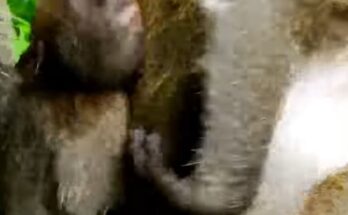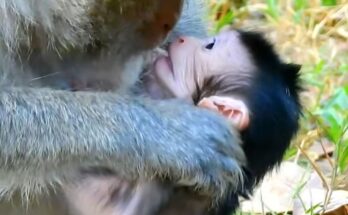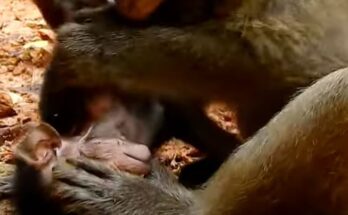Monkeys are fascinating creatures, known for their intelligence, social behavior, and curious antics. Among them, a particular monkey named “Sweetmeat” became the center of attention due to a peculiar problem: its unusual reaction of shaking its mouth after drinking water. This behavior puzzled observers, sparked concern among veterinarians, and captured the curiosity of animal lovers worldwide. But what caused Sweetmeat’s behavior, and what happened to this remarkable monkey?
Sweetmeat’s Rise to Fame
Sweetmeat lived in a densely forested area near a popular tourist destination. Known for its friendly demeanor and antics, Sweetmeat quickly became a favorite among visitors. It was not uncommon for Sweetmeat to interact with tourists, often accepting fruits, nuts, and snacks with apparent gratitude. Over time, Sweetmeat became somewhat of a local celebrity, with people traveling specifically to see this playful primate.
However, Sweetmeat’s fame took a turn when visitors noticed an odd behavior. Every time Sweetmeat drank water, it would shake its mouth vigorously, almost as if trying to expel something. Initially, this was dismissed as a quirky trait, but as the behavior persisted, concern grew. Was Sweetmeat experiencing discomfort or distress? Was this a sign of an underlying health issue?
Observations and Concerns
Tourists and local guides started documenting Sweetmeat’s behavior, sharing videos on social media. The footage showed the monkey tilting its head to drink water and then immediately shaking its mouth in a rapid, jerky motion. While some found the behavior amusing, others expressed concern about Sweetmeat’s well-being. Could the water source be contaminated? Was Sweetmeat suffering from a dental problem or another health issue?
Local animal welfare organizations took note of the viral videos and decided to intervene. A team of veterinarians and wildlife experts was assembled to observe Sweetmeat and determine the cause of its unusual behavior. This marked the beginning of an intensive investigation into the monkey’s health and habitat.
Diagnosing the Problem
Capturing a wild monkey for examination is no small feat. Sweetmeat was eventually lured into a humane trap using its favorite treats. Once in captivity, the veterinarians conducted a thorough examination. They looked for signs of injury, infection, or other physical abnormalities that could explain the mouth-shaking behavior.
The team discovered that Sweetmeat had several dental issues, including a cracked tooth and inflamed gums. These problems likely caused discomfort when drinking cold water, leading to the mouth-shaking reaction as an instinctive attempt to alleviate the pain. Additionally, the examination revealed a mild throat infection, which may have contributed to Sweetmeat’s discomfort.
Treating Sweetmeat
Addressing Sweetmeat’s health issues required careful planning. The veterinarians treated the monkey under anesthesia, cleaning its teeth, addressing the cracked tooth, and administering medication for the throat infection. They also provided supplements to improve Sweetmeat’s overall health and strengthen its immune system.
While Sweetmeat was in their care, the team also analyzed the water sources in the monkey’s habitat. Tests revealed traces of contaminants, including bacteria and debris that could exacerbate oral and throat infections. This prompted local authorities to take measures to clean the water sources, benefiting not just Sweetmeat but the entire monkey population in the area.
Sweetmeat’s Return to the Wild
After receiving treatment, Sweetmeat was released back into its natural habitat. Observers noted that the mouth-shaking behavior significantly decreased, a sign that the treatments were effective. Sweetmeat quickly readjusted to its environment and resumed its interactions with both its monkey peers and human visitors.
The story of Sweetmeat sparked a broader conversation about the impact of human activities on wildlife. Experts emphasized the importance of providing clean water sources and maintaining natural habitats to ensure the health and well-being of wild animals. Sweetmeat’s case also highlighted the need for responsible tourism. Feeding wild animals processed snacks and sugary treats can lead to dental problems and other health issues, as seen in Sweetmeat’s case.
Lessons Learned
Sweetmeat’s journey from a “problem monkey” to a symbol of wildlife care serves as a reminder of our responsibility toward nature. While Sweetmeat’s unusual behavior initially drew attention for its peculiarity, it ultimately underscored the importance of addressing the root causes of animal health issues.
For local communities, Sweetmeat’s story was an eye-opener about the challenges faced by wildlife coexisting with humans. Efforts were made to educate tourists and locals about the dangers of feeding wild animals inappropriate foods and the importance of preserving natural habitats.
Conclusion
Sweetmeat’s tale is one of resilience and recovery. What began as a puzzling behavior turned into a journey of diagnosis, treatment, and broader environmental awareness. Sweetmeat continues to thrive in its habitat, serving as a living testament to the impact of compassion and care in wildlife conservation. The next time Sweetmeat drinks water, there’s a good chance it’ll be a painless, ordinary act – and that’s something worth celebrating.


